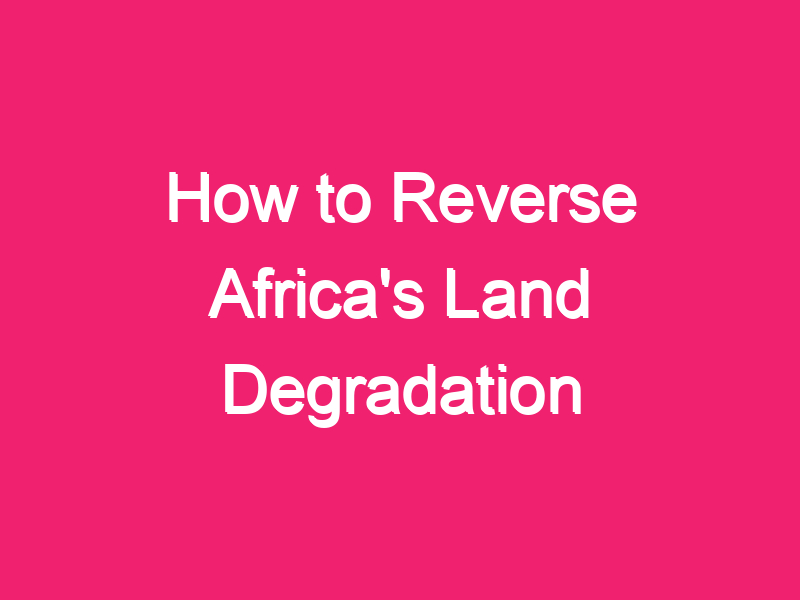
How to Reverse Africa’s Land Degradation
African countries are afflicted with land degradation, as they can’t afford to let it sit fallow and replenish itself. This over-use is causing soils to deplete in organic matter, making them unfit for growing crops. Many areas are as hard as concrete, and rain splashes off of it, making it even harder to grow crops. Here are a few ways to reverse land degradation in Africa.
Overgrazing
How to reverse Africa’s land degradation through overgrazing? Currently, two-thirds of Africa is degraded. The causes of this degrading state are high levels of poverty, overgrazing, and deforestation. Deforestation and overgrazing have reduced the land’s productivity and reduced household income, while reducing biodiversity. These problems can also worsen social and political instability, and even conflict.
Deforestation is a consequence of overgrazing, which leads to the conversion of arable land to an unproductive piece of land. The animals eat the vegetation that helps protect soil from erosion, and they leave the soil barren and infertile. Overgrazing is also a leading cause of desertification, as it destroys much of the pasture. Eventually, the deteriorated soil is unable to sustain the growth of crops and trees.
Excessive cultivation
This report analyses 105 million hectares of cropland across 42 African countries, comprising approximately 45 percent of the total arable land in the continent. It reviews economic costs of soil erosion at regional scales, and analyzes the limitations and challenges of different soil erosion measurement methodologies. The report also offers policymakers with recommendations for how to reverse Africa’s land degradation. It is a useful resource for governments, private organizations, and communities who wish to preserve the land.
The rate of soil erosion is a critical indicator of land degradation. Niger’s soils were the worst affected, with over seventy percent of the land highly degraded. Kenya had the largest variations in soil erosion, with the highest average of 150 trees per hectare. However, in this country, farmers are more likely to report planting trees than they are to report the absence of trees. Excessive cultivation, on the other hand, can help reclaim this degraded land and turn it into viable cropland.
Deforestation
The National Action Programme to Combat Desertification has committed South Africa to reducing deforestation and land degradation. In the South African context, communal tenure is the leading predictor of land degradation. Abiotic factors such as land use, water availability, and species composition are secondary predictors. During land redistribution, many areas were brought under communal land tenure. The encroachment of woody plants and the degradation of these lands received extensive attention.
The Food and Agriculture Organization (FAO) and the African Union Development Agency-NEPAD report that net deforestation in 45 African countries between 1990 and 2016 confirms EKC’s hypothesis. The regression model suggests that the turning point is US $3,300 per country. Population density and the proportion of rural inhabitants have negative and positive impacts on deforestation. The net loss of forests in sub-Saharan Africa is increasing, with four million hectares of forest disappearing every year.
Poaching
Many parts of Africa have been devastated by deforestation and drought, with much of the land unusable for farming. There are millions of people struggling to survive off degraded land and few industrial jobs. Most of Africa’s population is dependent on farming and forestry for survival, with nearly 70 percent of its population living off it. In many cases, land is now as hard as concrete, and rain splashes off the hard ground.
Meanwhile, farmland is rapidly being turned into shopping malls and housing tracts. Farms are being turned into neat houses and colossal malls, and farmers are destroying wildlife habitats. In the last decade alone, ivory poachers killed more than 100,000 elephants and rhinos. Cheetah populations are also declining, and new farms and fences threaten to destroy their habitats.
Climate change
As the sixth mass extinction of species continues, the world needs to do more than ever to reverse land degradation. The costs of land degradation exceed ten percent of world GDP, and climate change is accelerating this trend. The recent 15th Conference of the Parties to the United Nations Convention to Combat Desertification in Cote d’Ivoire saw new frameworks launch to restore forests, boost food production, create jobs for young people, and lift rural women out of poverty.
The African Union has committed to the Great Green Wall initiative, an ambitious program to restore Africa’s degraded land and transform millions of lives in the Sahel. The initiative aims to restore 100 million hectares of land, capture 250 million tons of carbon, and create ten million green jobs. Since its inception, the Great Green Wall initiative has made progress on restoring Sahelian lands. Its first phase has helped plant 18 million trees in Senegal, eight million in Nigeria, and 129 million in Eritrea and Niger.


